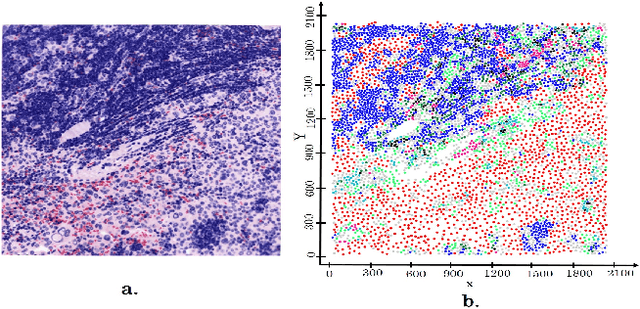Svetomir N. Markovic
Spatially-Delineated Domain-Adapted AI Classification: An Application for Oncology Data
Jan 20, 2025



Abstract:Given multi-type point maps from different place-types (e.g., tumor regions), our objective is to develop a classifier trained on the source place-type to accurately distinguish between two classes of the target place-type based on their point arrangements. This problem is societally important for many applications, such as generating clinical hypotheses for designing new immunotherapies for cancer treatment. The challenge lies in the spatial variability, the inherent heterogeneity and variation observed in spatial properties or arrangements across different locations (i.e., place-types). Previous techniques focus on self-supervised tasks to learn domain-invariant features and mitigate domain differences; however, they often neglect the underlying spatial arrangements among data points, leading to significant discrepancies across different place-types. We explore a novel multi-task self-learning framework that targets spatial arrangements, such as spatial mix-up masking and spatial contrastive predictive coding, for spatially-delineated domain-adapted AI classification. Experimental results on real-world datasets (e.g., oncology data) show that the proposed framework provides higher prediction accuracy than baseline methods.
Towards Spatially-Lucid AI Classification in Non-Euclidean Space: An Application for MxIF Oncology Data
Feb 22, 2024Abstract:Given multi-category point sets from different place-types, our goal is to develop a spatially-lucid classifier that can distinguish between two classes based on the arrangements of their points. This problem is important for many applications, such as oncology, for analyzing immune-tumor relationships and designing new immunotherapies. It is challenging due to spatial variability and interpretability needs. Previously proposed techniques require dense training data or have limited ability to handle significant spatial variability within a single place-type. Most importantly, these deep neural network (DNN) approaches are not designed to work in non-Euclidean space, particularly point sets. Existing non-Euclidean DNN methods are limited to one-size-fits-all approaches. We explore a spatial ensemble framework that explicitly uses different training strategies, including weighted-distance learning rate and spatial domain adaptation, on various place-types for spatially-lucid classification. Experimental results on real-world datasets (e.g., MxIF oncology data) show that the proposed framework provides higher prediction accuracy than baseline methods.
MC-DGCNN: A Novel DNN Architecture for Multi-Category Point Set Classification
Dec 22, 2021



Abstract:Point set classification aims to build a representation learning model that distinguishes between spatial and categorical configurations of point set data. This problem is societally important since in many applications domains such as immunology, and microbial ecology. This problem is challenging since the interactions between different categories of points are not always equal; as a result, the representation learning model must selectively learn the most relevant multi-categorical relationships. The related works are limited (1) in learning the importance of different multi-categorical relationships, especially for high-order interactions, and (2) do not fully exploit the spatial distribution of points beyond simply measuring relative distance or applying a feed-forward neural network to coordinates. To overcome these limitations, we leverage the dynamic graph convolutional neural network (DGCNN) architecture to design a novel multi-category DGCNN (MC-DGCNN), contributing location representation and point pair attention layers for multi-categorical point set classification. MC-DGCNN has the ability to identify the categorical importance of each point pair and extends this to N-way spatial relationships, while still preserving all the properties and benefits of DGCNN (e.g., differentiability). Experimental results show that the proposed architecture is computationally efficient and significantly outperforms current deep learning architectures on real-world datasets.
 Add to Chrome
Add to Chrome Add to Firefox
Add to Firefox Add to Edge
Add to Edge